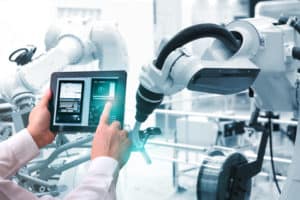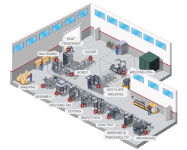
Unlike human workers or traditional machines, robotic cells are autonomous and can consistently perform complex tasks over night, weekend, and holiday shifts without the presence of a controller. Examples of tasks include detecting leakage, assembly, welding, testing, and transferring products to their next station. The lack of human intervention streamlines production efficiency. Read on to learn why robotic cells are the future of manufacturing.
Assembly Line Efficiency: Traditional Manufacturing vs. Robotic Cells
Early automobile manufacturers such as Ford used a classic assembly line to manufacture cars. Traditional manufacturing comprised several steps performed by different workers to come up with a single product. The end products were often large and complex, but despite their complexity, they were all identical. The process relied on balanced timing from station to station, but relying on human workers led to increased wait times as workers down the line waited for their colleagues in previous stations to finish their part. This waiting resulted in labor-intensive, inefficient production.
As technology has advanced and demand for product variation increased, manufacturers have attempted to adapt their assembly lines. To accommodate differences between products, some products need more time to manufacture than others. However, this leads to decreased productivity and increased waiting time. Manufacturers—and their customers—require a more innovative solution.
Automated manufacturing is increasingly replacing traditional manufacturing. An automated assembly system still utilizes the sequential process of classic manufacturing, but automated lines have more machines and fewer human workers. This feature has greatly reduced human error, added the capability of accommodating product variation, lowered long-term production costs, and made the workplace safer.
Robotic cells can be used to handle different tasks, such as:
- Pick and place
- Deburring
- Sorting
- Assembly
- CNC machine tending
- Painting
- Finishing and polishing
- Welding
Robotic Cells Have a Fast ROI
Although robotic cells require a significant initial cost, they offer a quick return on investment, which is a key factor when working on a tight budget. Companies can receive a full ROI within as little as a year when working with robotic cells. The cost of hiring and retaining employees to work on different parts of the manufacturing process can accrue over the years. Robotic cells significantly lower the cost of human labor, leading to increased productivity and profits. Instead, companies can hire human employees for more complex and fulfilling roles, such as engineering and programming.
Enhanced Safety in a Robotic Cell
Another great advantage of robotic cells is the safety aspect. Robotic cells have scanners, fencing, emergency stops, light curtains, and additional safeguards to ensure employee safety while working close to these machines. Robotic cells can also easily handle tasks that would otherwise be high-risk to workers, such as processes that use toxic chemicals, sharp objects, and heavy machinery.
Flexibility of Robotic Cells
Today, customers want to have personalized products. For example, when you buy a car you want to be able to choose the exterior and interior colors, sound system, etc. Conversely, traditional fixed automation is not flexible enough to handle personalized production. Robotic cells, however, offer much more flexibility when it comes to personalizing the product to a customer’s liking as well as all the benefits mentioned above. The robot’s inherent flexibility in handling a wide variety of products is also very convenient when many variations need to be handled by the same assembly line.
Needless to say, new manufacturing technologies are programmable to fit the expertise or the needs of your personnel and assembly line.
Your Partner for Your Robotic Work Cell Needs
The advantages of robotic cells far outweigh those of traditional manufacturing. At AMD, we are experts in designing and manufacturing custom robotic cells for different applications based on our customers’ unique needs. If a robotic work cell doesn’t fit your process, AMD provides manual, semi-automated, and fully-automated machines. With the help of our experienced team of robotic specialists, you can select the solution that works best for you. Contact us today or request a quote to get started on your solution.


1 Comment
Nayman
Pretty section of content. I enjoyed your blog post.